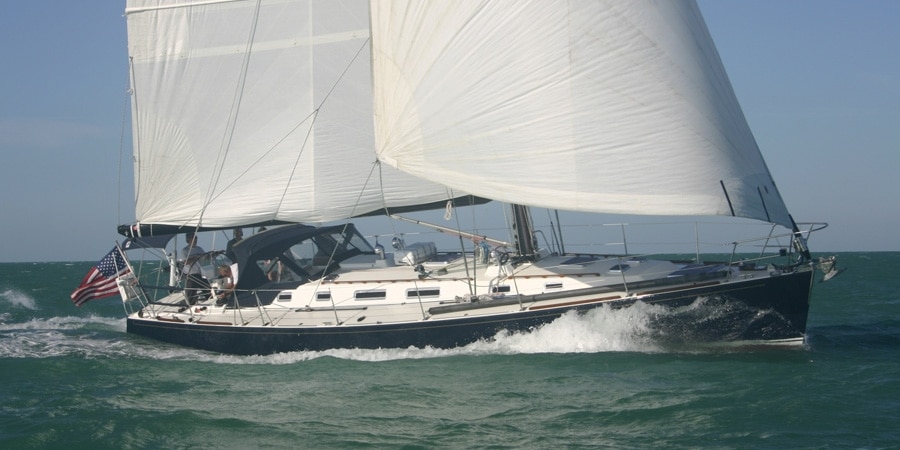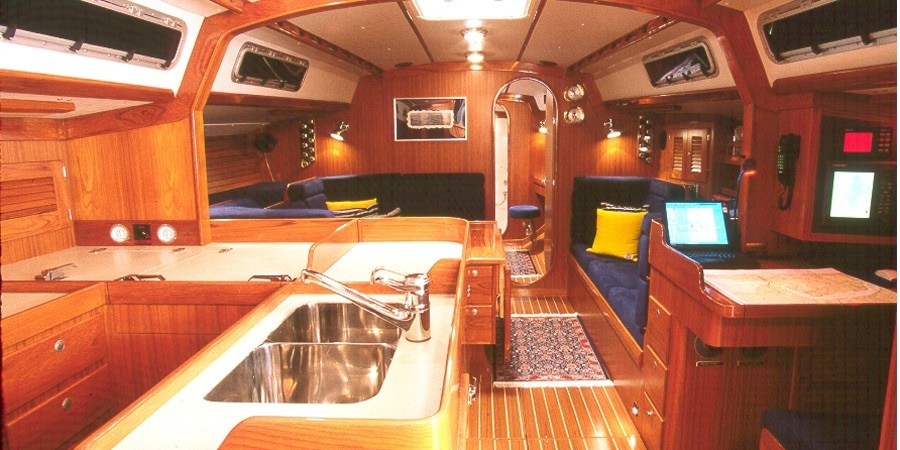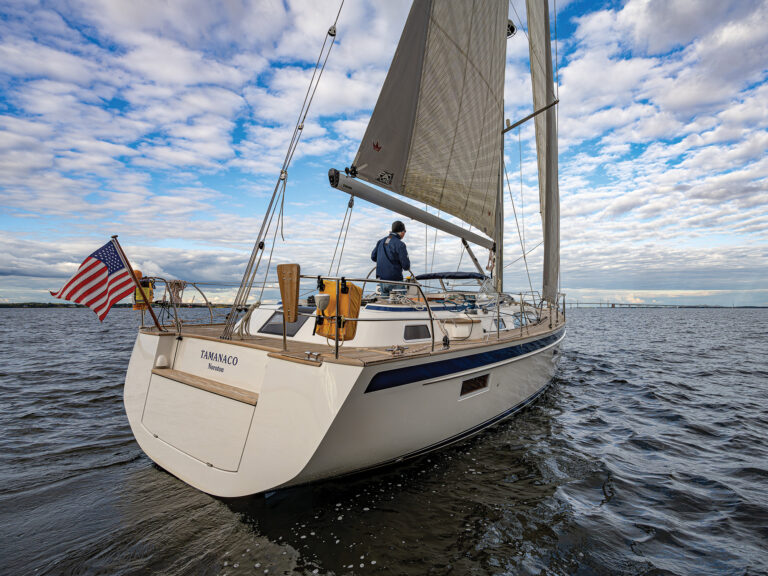
While the racing heritage of the J/Boats-TPI partnership is legendary and their genuine contribution to the Joy Of Sailing enormous, nothing yet produced by that design-and-build team punctuates those achievements as impressively as the new J/160. In today’s world of better equipment, more exotic materials and truly sophisticated design, stretching the parameters of the old “performance cruiser” is long overdue. This boat gives modern sailors racing and cruising performance without requiring the burden of a large crew. On a more subjective level, all in a glance she is clean, simple, elegant, comfortable, fast and capable.
With modern composite construction, a typically easily-driven J/Boat hull form and a very low center of gravity, the 160 needs less sail area for comparable performance than do other sailboats in the 50-foot-plus size range. This translates into lower winch loads, easier sail management, more relaxed cruising and racing.
The standard Hall triple-spreader aluminum rig (a Hall carbon fiber rig is a tempting, albeit expensive, option) carries a large, low-aspect-ratio mainsail and a comparatively small, high-aspect-ratio foretriangle. This big-main/small-headsail combination is efficient for any kind of sailing and easily managed by a diminutive crew. For relaxed cruising or offshore work, a furling #3 jib is recommended in conjunction with the main. The jib is a cinch to tack, and trimming the main with the 6:1 Lewmar Ocean Racing mainsheet traveler system is equally unconstrained.
On deck and in the cockpit the hardware and winches are arranged so that almost all sail handling, hoisting and trimming can be done easily from a safe position aft. Sitting outboard of the large (66″) wheel gives the helmsperson an excellent view forward, and this driver’s seat actually becomes more comfortable as the boat heels. Leaving the helm station to go forward in the cockpit is a step-up-and-go-around-the-wheel affair, potentially awkward in dicey sailing conditions. All the way aft, the scoop transom makes for convenient boarding from the water, dinghy or dock. Up on the bow, a large storage locker with an overhead deck hatch provides room to stow sails, ground tackle, lines, fenders and errant gear.
Setting a spinnaker on a 53-foot sailboat without a full crew was never at the top of most people’s Must Do list. Enter the modern-day asymmetrical kite, a retractable pole disguised as a bowsprit, and a cockpit-operated snuffer system. On the 160, relaxed shorthanded spinnaker work becomes routine. And that’s without even going forward.

Belowdeck, the 160 is nothing short of elegant. The interior is offered in all-teak or all-cherry wood, with enough off-white laminate and trim to promote that open, spacious sensation. The layout emphasizes liveaboard and long-term cruising comfort, with pumps and machinery grouped in convenient, accessible locations for easy inspection and service.
Aft of the companionway to port and starboard are two staterooms, one accessible to the after head, sink and shower. The cabins are snug yet comfortable, with 48-inch wide berths and good available storage. Just forward of the companionway to port is a roomy J-shaped galley, with a double sink close to centerline and a gimbaled three-burner Force 10 stove outboard. Icebox/refrigerator capacity is vast (12.5 cubic feet), general storage is ample, the wraparound design of the galley, secure and safe.
The forward-facing nav station opposite the galley offers visible and protected space for mounting the latest yacht electronics. Extra-tall fiddles keep charts, books and pencils from ending up on the floor; a curved, contoured seat keeps the navigator from doing the same. The main saloon features a settee berth to starboard and a full-size pilot berth outboard of the oval dining settee to port. All the way forward is the owner’s cabin — truly a “stateroom” — with a 56″ x 78″ double berth, shelves, storage and hanging lockers, a vanity, a private head with shower…the works.
Engine and mechanical installations are excellent. Seacocks are tagged, all plumbing hoses below the waterline are double clamped, access to machinery — engine, shaft, optional generator, watermaker and so on — is handy, and ventilation to those areas is good. A turbo-charged 88-horsepower Yanmar connected to a 22-inch Martec folding prop delivers a comfortable and quiet cruising speed of 8 knots plus. Tankage is formidable at 95 gallons for fuel and 162 for fresh water.
Construction emphasizes light weight by way of TPI’s signature SCRIMP resin-infusion molding technique. Hull and deck are cored with Baltek end-grain balsa, with solid glass at critical structural junctures such as where the chainplates attach. All bulkheads are tabbed on both sides. Hull-to-deck features an in-turned flange sealed with structural sealant and fastened mechanically every four inches.
The hull is designed with a fine entry and short overhangs, moderate topside flare, and a low-wetted-surface underbody. The rudder is a balanced high-aspect spade. Two antimony-hardened cast lead keels are offered, the deeper of which is 11,000 pounds and draws 8’10″, the other 12,000 pounds and 7’0″. They are externally mounted. The non-dimensional ratios point to a lot of sailpower and relatively light displacement, and the limit of positive stability according to the designer is a whopping 140 degrees (a respectable 125 degrees by IMS calculations).
Sailing the 160 is every bit as fun as advertised. Hoisting the main takes a tolerable amount of effort (unless you spring for the electric winch option), and from there you simply pick a direction and go fast. Extending the bowsprit, setting the kite, jibing it and dousing it are simple. Behavior on all points of sail is truly refined; the platform feels as stable as something much larger, but the response to helm, trim and tweaking is very apparent.
The base price of the J/160 is advertised at $497,550, with an estimated sailaway figure, depending upon your choice of equipment, sails and rig, in the $550,000 to $700,000 range. If you require quality, performance, elegance, safety, a yacht built to exceed the Offshore Yacht Service standards of ABS, and a 10-year hull warranty against blistering, then this boat has to be at the top of the list. Rod Johnstone has expanded the parameters of the “performance cruiser” genre, and TPI has built the vessel strong enough to prove that lighter can be better.








